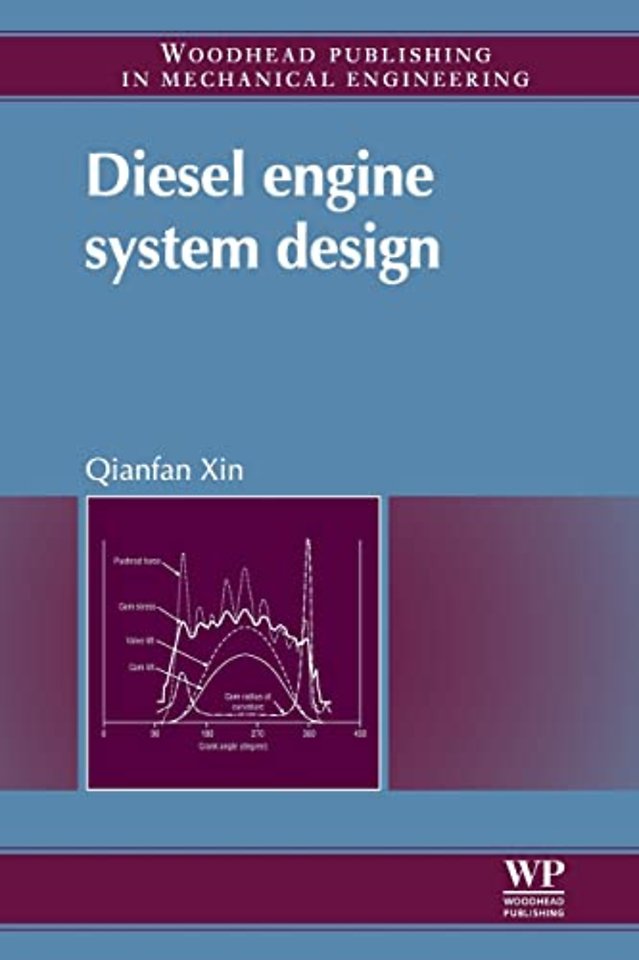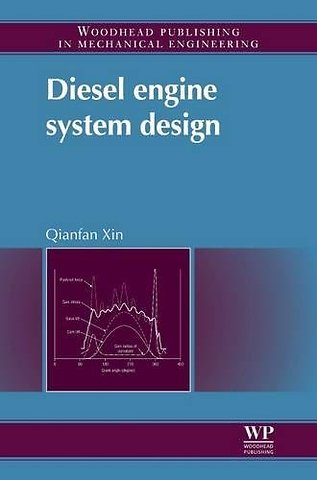<p>Nomenclature</p> <p>List of abbreviations and acronyms</p> <p>Dedication</p> <p>About the author</p> <p>Preface</p> <p>Part I: Fundamental concepts in diesel engine system design – analytical design process, durability, reliability, and optimization</p> <p>Chapter 1: The analytical design process and diesel engine system design</p> <p>Abstract:</p> <p>1.1 Characteristics and challenges of automotive diesel engine design</p> <p>1.2 The concept of systems engineering in diesel engine system design</p> <p>1.3 The concepts of reliability and robust engineering in diesel engine system design</p> <p>1.4 The concept of cost engineering in diesel engine system design</p> <p>1.5 Competitive benchmarking analysis</p> <p>1.6 Subsystem interaction and analytical engine system design process</p> <p>1.7 Engine system design specifications</p> <p>1.8 Work processes and organization of diesel engine system design</p> <p>Chapter 2: Durability and reliability in diesel engine system design</p> <p>Abstract:</p> <p>2.1 Engine durability issues</p> <p>2.2 System design of engine performance, loading, and durability</p> <p>2.3 The relationship between durability and reliability</p> <p>2.4 Engine durability testing</p> <p>2.5 Accelerated durability and reliability testing</p> <p>2.6 Engine component structural design and analysis</p> <p>2.7 System durability analysis in engine system design</p> <p>2.8 Fundamentals of thermo-mechanical failures</p> <p>2.9 Diesel engine thermo-mechanical failures</p> <p>2.10 Heavy-duty diesel engine cylinder liner cavitation</p> <p>2.11 Diesel engine wear</p> <p>2.12 Exhaust gas recirculation (EGR) cooler durability</p> <p>2.13 Diesel engine system reliability</p> <p>1 The components with high reliability importance can be assigned a high reliability since a high importance indicates the component has a large impact on the overall system reliability</p> <p>Chapter 3: Optimization techniques in diesel engine system design</p> <p>Abstract:</p> <p>3.1 Overview of system optimization theory</p> <p>3.2 Response surface methodology (RSM)</p> <p>3.3 Advanced design of experiments (DoE) optimization in engine system design</p> <p>3.4 Optimization of robust design for variability and reliability</p> <p>Part II: Engine thermodynamic cycle and vehicle powertrain performance and emissions in diesel engine system design</p> <p>Chapter 4: Fundamentals of dynamic and static diesel engine system designs</p> <p>Abstract:</p> <p>4.1 Introduction to diesel engine performance characteristics</p> <p>4.2 Theoretical formulae of in-cylinder thermodynamic cycle process</p> <p>4.3 Engine manifold filling dynamics and dynamic engine system design</p> <p>4.4 Mathematical formulation of static engine system design</p> <p>4.5 Steady-state model tuning in engine cycle simulation</p> <p>Chapter 5: Engine–vehicle matching analysis in diesel powertrain system design</p> <p>Abstract:</p> <p>5.1 The theory of vehicle performance analysis</p> <p>5.2 Engine–vehicle steady-state matching in engine firing operation</p> <p>5.3 Powertrain/drivetrain dynamics and transient performance simulation</p> <p>5.4 Optimization of engine–vehicle powertrain performance</p> <p>5.5 Hybrid powertrain performance analysis</p> <p>Chapter 6: Engine brake performance in diesel engine system design</p> <p>Abstract:</p> <p>6.1 Engine–vehicle powertrain matching in engine braking operation</p> <p>6.2 Drivetrain retarders</p> <p>6.3 Exhaust brake performance analysis</p> <p>6.4 Compression-release engine brake performance analysis</p> <p>Chapter 7: Combustion, emissions, and calibration for diesel engine system design</p> <p>Abstract:</p> <p>7.1 The process from power and emissions requirements to system design</p> <p>7.2 Combustion and emissions development</p> <p>7.3 Engine calibration optimization</p> <p>7.4 Emissions modeling</p> <p>Chapter 8: Diesel aftertreatment integration and matching</p> <p>Abstract:</p> <p>8.1 Overview of aftertreatment requirements on engine system design</p> <p>8.2 Diesel particulate filter (DPF) regeneration requirements for engine system design</p> <p>8.3 Analytical approach of engine–aftertreatment integration</p> <p>Part III: Dynamics, friction, and noise, vibration and harshness (NVH) in diesel engine system design</p> <p>Chapter 9: Advanced diesel valvetrain system design</p> <p>Abstract:</p> <p>9.1 Guidelines for valvetrain design</p> <p>9.2 Effect of valve timing on engine performance</p> <p>9.3 Valvetrain dynamic analysis</p> <p>9.4 Cam profile design</p> <p>9.5 Valve spring design</p> <p>9.6 Analytical valvetrain system design and optimization</p> <p>9.7 Variable valve actuation (VVA) engine performance</p> <p>9.8 Variable valve actuation (VVA) for diesel homogeneous charge compression ignition (HCCI)</p> <p>9.9 Cylinder deactivation performance</p> <p>Chapter 10: Friction and lubrication in diesel engine system design</p> <p>Abstract:</p> <p>10.1 Objectives of engine friction analysis in system design</p> <p>10.2 Overview of engine tribology fundamentals</p> <p>10.3 Overall engine friction characteristics</p> <p>10.4 Piston-assembly lubrication dynamics</p> <p>10.5 Piston ring lubrication dynamics</p> <p>10.6 Engine bearing lubrication dynamics</p> <p>10.7 Valvetrain lubrication and friction</p> <p>10.8 Engine friction models for system design</p> <p>Chapter 11: Noise, vibration, and harshness (NVH) in diesel engine system design</p> <p>Abstract:</p> <p>11.1 Overview of noise, vibration, and harshness (NVH) fundamentals</p> <p>11.2 Vehicle and powertrain noise, vibration, and harshness (NVH)</p> <p>11.3 Diesel engine noise, vibration, and harshness (NVH)</p> <p>11.4 Combustion noise</p> <p>11.5 Piston slap noise and piston-assembly dynamics</p> <p>11.6 Valvetrain noise</p> <p>11.7 Geartrain noise</p> <p>11.8 Cranktrain and engine block noises</p> <p>11.9 Auxiliary noise</p> <p>11.10 Aerodynamic noises</p> <p>11.11 Engine brake noise</p> <p>11.12 Diesel engine system design models of noise, vibration, and harshness (NVH)</p> <p>Part IV: Heat rejection, air system, engine controls, and system integration in diesel engine system design</p> <p>Chapter 12: Diesel engine heat rejection and cooling</p> <p>Abstract:</p> <p>12.1 Engine energy balance analysis</p> <p>12.2 Engine miscellaneous energy losses</p> <p>12.3 Characteristics of base engine coolant heat rejection</p> <p>12.4 Cooling system design calculations</p> <p>12.5 Engine warm-up analysis</p> <p>12.6 Waste heat recovery and availability analysis</p> <p>Chapter 13: Diesel engine air system design</p> <p>Abstract:</p> <p>13.1 Objectives of engine air system design</p> <p>13.2 Overview of low-emissions design and air system requirements</p> <p>13.3 Exhaust gas recirculation (EGR) system configurations</p> <p>13.4 Turbocharger configurations and matching</p> <p>13.5 Exhaust manifold design for turbocharged engines</p> <p>13.6 The principle of pumping loss control for turbocharged exhaust gas recirculation (EGR) engines</p> <p>13.7 Turbocompounding</p> <p>13.8 Thermodynamic second law analysis of engine system</p> <p>Chapter 14: Diesel engine system dynamics, transient performance, and electronic controls</p> <p>Abstract:</p> <p>14.1 Overview of diesel engine transient performance and controls</p> <p>14.2 Turbocharged diesel engine transient performance</p> <p>14.3 Mean-value models in model-based controls</p> <p>14.4 Crank-angle-resolution real-time models in model-based controls</p> <p>14.5 Air path model-based controls</p> <p>14.6 Fuel path control and diesel engine governors</p> <p>14.7 Torque-based controls</p> <p>14.8 Powertrain dynamics and transient controls</p> <p>14.9 Sensor dynamics and model-based virtual sensors</p> <p>14.10 On-board diagnostics (OBD) and fault diagnostics</p> <p>14.11 Engine controller design</p> <p>14.12 Software-in-the-loop (SIL) and hardware-in-the-loop (HIL)</p> <p>14.13 Cylinder-pressure-based controls</p> <p>14.14 Homogeneous charge compression ignition (HCCI) controls</p> <p>Chapter 15: Diesel engine system specification design and subsystem interaction</p> <p>Abstract:</p> <p>15.1 The process of system design analysis</p> <p>15.2 Roadmap of fuel economy improvement</p> <p>15.3 Critical mode design at various ambient conditions</p> <p>15.4 Subsystem interaction and optimization</p> <p>Chapter 16: Concluding remarks and outlook for diesel engine system design</p> <p>Abstract:</p> <p>Appendix: Statistics summary for probability analysis</p> <p>Index</p>

